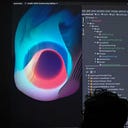Is there anything more surreal than reality?
It was on my way home, when I was flying from New York back to Berlin. Layover in Brussels brought me into the system of airport corridors, these veins pushing the bloodstream of human bodies always in the same direction, towards our destinations. But there are also distractions on the way. Cafés, restaurants, bakeries, are all calling us with their artificially charming coziness, to make us feel like being in the space which is not designed, but organically evolved in the social tissue of some imaginary neighborhood. There are churches here as well — all the duty-free shops. Actually they are not really mimicking churches, rather just altars abstracted from any context, built to evoke perception of holiness inside a temple. Exceptionally bright, filled with strings of directional light which is producing as many sparkly reflections as possible, out of all the luxury relics congregated here. Things mostly useless, as disposable as any other cheap memorabilia soon we might not want to remember. The mechanics of capitalism is not built on our need of owning objects. It’s about our addiction to this experience of prestige which we feel when we exercise our privilege.
Everything there was made according to the standard expected from the city hosting European parliament. Vast fabric of aspired perfectness impressing Donald Trump so much in comparison to his domestic experience of ugliness at JFK. But suddenly I noticed weird disruptions in the continuity of these corridors — patches of imperfection in this fabric. Some of the walls and entries to some of the passages were covered with plain, gray, ad hoc installed panels. I realized immediately that it had been still not that long after terrorist attacks which disrupted this vascular system with the red paint coming out of human arteries — something I would never ever want to see with my own eyes. Thanks God for the forces behind capitalist rituals, protecting us from the ugliness of entropy, for the price of being disconnected from what we feel.
Only few people were waiting for the flight to Berlin when I took this picture. The specimen of the third subspecie of the chimpanzee, wearing technologically advanced footwear, providing “barefoot” experience (nota bene I use the same model for running, as it connects me better with my inner ape), sleeping peacefully on the floor, in disregard for cultural conventions restricting such a behavior, underneath the quintessence of a highly-cultured intellectual fetish. A reference to the iconic Magritte’s man in a bowler hat. Airport’s self-promoting poster worshiping surrealist iconostasis, which was exploring Freudian unconscious so deeply, in the context of individual experience, but which is replicated here on many billboards just to convey a marketing slogan of the late capitalism, to the audience demanding slightly more prestige in their experience. A perfect order of civilizational artifacts under the blue sky, with the cutest fluffy clouds. Had this graphic design been prepared already, before the attack happened?
Magritte has been always giving me this unique feeling of comfort. Safety of his composition which is symbolically closed, constrained, unequivocally focused. I feel meditative consolation while seeing through the window of my own closet, filled with personal “values”. But stillness is the move. Homeostasis is just an illusion. Perceived equilibrium comes from this unimaginable tension between these invisible opposite forces of connection and disconnection, attachment and detachment, association and disassociation. And these repetitive patterns of civilizational habits are always screaming “disrupt me”, kill me to be free.
So I feel the vibe. We love surrealism, indeed. Even if Magritte’s closed composition is suddenly opened with incoherent correctness of the gender balance. The black dress revealing nakedness of the strong arms. The ultimate objectification of the female body, which is put there to fill the gap in the purpose-driven commercial narrative. Want some surrealism? Exploring what’s unconscious? Maybe it’s enough to just look around in the reality, when you know your inside slightly better.
I went to New York to share the same space and time with Polly Yim, my partner living on the other side of the Ocean. Polly is an artist, she wants to be one. She’s hungry to be one. But she doesn’t have to be. Because she is the art.
Polly opened a door for me, I am not sure when and I am not sure how. I didn’t even know it existed. Once her friend asked if I am an artist too, as it seems to be a “currency” determining person’s value in certain social environments. She responded: “No, Kazik is not an artist. But he would be if he decided to.”. I am not an artist. I don’t need to be, to define myself. Still I want to express myself in creation. I need to. It’s the only way for me to heal the trauma of disassociation, to make the grief bearable.
I helped Polly in some of her projects. When she was building a theremin, which she wanted to use in a piece about governmental control over Liu Xia‘s body. There was also another very personal project she called “kochiyama”. I built a bot for her, machine agent based on phenomenological model of a mind, acting out of desires objectifying and fetishizing the bodies of Asian women.
Once Polly took me to Oranienburg, to brake together into abandoned bakery. Quite inorganically grown structure, built within a different social tissue, to supply the bread to the nazi concentration camp. She wanted to take some pictures there with her self-constructed pinhole camera. I was watching her, the artist at work, with unspeakable admiration.
Maybe in those dark corridors, build by the slaves of the fascist regime and soaked with their sweat and blood but now covered with a pink graffiti, maybe there I saw a door to this total vividness.
